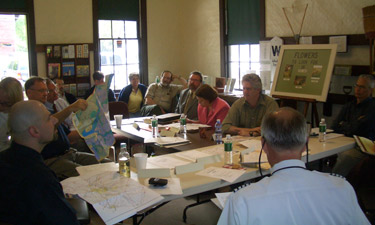
Innovation: Getting multiple jurisdictions and organizations in several states to work together for mutual benefit of creating a long-distance historic and scenic trail.
Summary: The concept of the Grand History Trail, a long-distance trail linking significant historic locations in Pennsylvania, Maryland, Virginia, and the District of Columbia, was conceived by Don Gogniat, former vice-chair of the York County Rail Trail Authority. While not a “done deal” yet, the trail planning has gained national organizational supporters and significant regional and local support.
Historic Ties of Mid-Atlantic States for Commerce and Trade Lead to Visionary Trail Plan
A volunteer leader of the York County Rail Trail Authority was doodling on the back of a napkin during a committee meeting of the authority some years ago when an idea struck him. What if some of the key historic and scenic trails in Pennsylvania, Maryland, Virginia, and DC could all be linked into one grand loop trail, a kind of grand history loop trail? So thought Don Gogniat, a former board member and vice-chair who is a geographer by profession, and long-time administrator at Penn State University. Thus was born the concept for the Grand History Trail.
Since the creation of the York County Rail Trail Authority in 1990, the organization has worked on the designation and construction of converted rail trails and other connecting trails to create a regional trail network in southern Pennsylvania and beyond. Deal with complex real estate holdings and difficult negotiations with farmers, landowners, rail operators and the public, the authority has had to meet each new situation with out-of-the-box thinking to devise workable solutions to move trail projects from planning concepts to real on-the-ground trails.
The challenges have caused the authority to be willing to take risks and be innovative in their thinking if they wanted to be successful. The Grand History Trail has been a unifying concept that has begun to bring together governmental agencies, economic development interests, and political jurisdictions in support of the many benefits such a trail could bring in tourism and economic development. It has been the catalyst for new partnerships, and new ways of thinking how to solve complex challenges.
Gogniat says that this is an easy way for governments to work together, and he is committed to getting the governor of Pennsylvania to talk with the governor of Maryland and commit to a plan of true regional cooperation. “This is a natural. How could elected officials not support a plan that would make people healthier, promote economic development, and connect people?”
Gogniat says, “This is not a done deal yet. While we have great support from organizations like the Rails to Trails Conservancy, which has taken this on as priority, we will probably need support at the national level—perhaps the designation as a National Historic Trail.”
Tip: Getting a project like this done—take the first step. The biggest step is the first step.
Challenge: There are about 100 miles left to connect, with the largest portion from Gettysburg to the C&O Canal. “But there are multiple options,” Gogniat says. “We can find the connections.” The biggest challenge? Finding funding in a very uncertain economic climate, especially the federal matching funds that have been traditionally provided for trails like this through the federal transportation bill.
Going forward: “This project has captured the interest and support of business people who see that this project can change the vision for the region,” Gogniat says. “They realized that we weren’t just talking about a trail here and a trail there, but a regional system that could truly connect people and places and bring economic value.”

